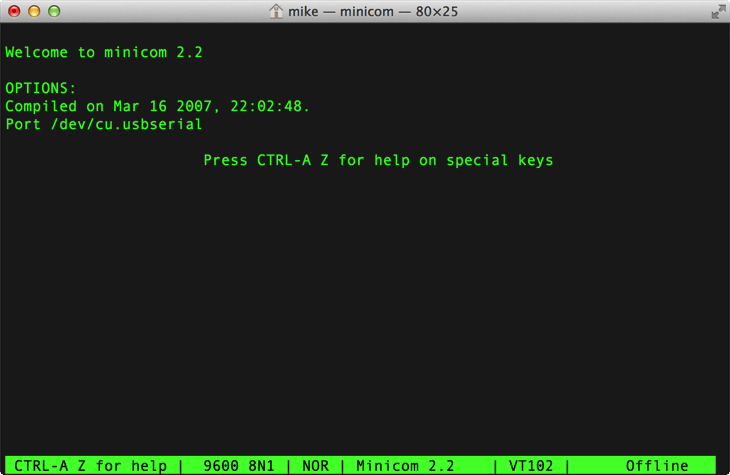Tiny TTY Mac OS
You can use minicom on a Mac OS X Server setup, too, but you'll have to use /dev/tty.serial as a configuration parameter. It also works fine with the KEYSPAN Adapter USB to Serial cable ( /dev/tty.USA28X2b23P1.1 on my machine).
Mac Os Versions
Mac OS (All cursers) Cursor Set by yellowwinner. All of the Mac OS pointers. Tiny 8-Bit Cursors. By RIDDLER 106 This is the real 8-Bit cursor set in monochrome. MacOS Sierra (version 10.12) is the thirteenth major release of macOS (previously known as OS X and Mac OS X), Apple Inc.' S desktop and server operating system for Macintosh computers. The name 'macOS' stems from the intention to uniform the operating system's name with that of iOS, watchOS and tvOS. Sierra is named after the Sierra Nevada mountain range in California and Nevada. MacOS versions tested and working with this EFi configuration: Yosemite, El Capitan, Sierra, High Sierra, Mojave and Catalina up to 10.15 beta 4. I Picked up a Lenovo M93p Tiny PC for a TV box/PC Hackintosh project and it was real easy to get up and running. It took all of ten minutes to.
| Click here to return to the 'Use minicom as a serial-interface terminal application' hint |
Mac Os Mojave

Tiny Tty Mac Os Catalina
Won't build in 10.2.8 - which is too bad because the fink version has trouble with my eMac's modem. Always takes a couple tries before it can talk to the modem. Then it works flawlessly.
Anybody else seen this behaviour? I've been living with it for a year or so now.
Greg Shenaut
In the past minicom haws had numerous security vulnerabilities, so if past experience is any indication I would continue to use Kermit. Besides kermit has a ton of very powerful features. (Like you can use kermit between a HP48 calculator.)
I'm curious: what are serial interfaces? What's an example or two of the things you are talking about?
I'm curious, but I imagine this might be useful if it's what I think it is. A coworker manages a digital closed-circuit television system that has something to do with RS-232, I hear.
---
--
osxpounder
Greg Shenaut
The open source 'screen' command is pre-installed in the Mac OS X.
Solaris users will recall the 'tip' command. I use 'screen' and a
USB-serial adapter when I need quick-and-dirty terminal emulation
via a serial port.
screen man page:
screen -r [[pid.]tty[.host]]
screen -r sessionowner/[[pid.]tty[.host]]
DESCRIPTION
Screen is a full-screen window manager that multiplexes a
physical terminal between several processes (typically
interactive shells). Each virtual terminal provides the
functions of a DEC VT100 terminal and, in addition, sev-
eral control functions from the ISO 6492 (ECMA 48, ANSI
X3.64) and ISO 2022 standards (e.g. insert/delete line and
support for multiple character sets). There is a scroll-
back history buffer for each virtual terminal and a copy-
and-paste mechanism that allows moving text regions
between windows.
clip
For the curious - the FreeBSD tip(1) source builds and runs on MacOSX as is - just remove the FreeBSD macros `__FBSDID($FREEBSD$);' and use bsdmake(1). To attach to the modem, use `cu -l /dev/tty.modem'.
I would absolutely love to recover my old cu utility, but I searched through the FreeBSD ports database and they don't have a specific 'tip' port. Could you give us more details on how to get tip or cu to work on OSX (where to find the source, what to change in the code to get it to compile it, ect...).
I did try to compile UUCP a while back but I was never able to squeeze a binary out of the source code.
Thanks for the 'TIP'
CU
;-)
I should not have alluded to 'tip' in Solaris... it confused folks.
The command that's pre-installed in Jaguar/Panther is 'screen'
(refer to the 'screen' man pages via the terminal).
I'll leave comments about 'cu' to someone else.
Could you please give the exact syntax of the screen-command you use to connect to tty.modem and to your USB-Serial-Adapter.
---
Jean-Claude Eischen
Swiss Federal Institute of Technology
Zurich - Switzerland
Thank you!!! I've been trying to figure out how to get tip/cu finctionality out of OSX. I was using zterm, but it crashes hard, and I can't kill it, even with a 'kill -9' I have a soekris Net4801 that I would like to connect to via a IOGear USB-Serial adapter. This did the trick!
FYI, the command was:
screen /dev/tty.usbserial (depends on the device your driver creates)
-Andy
I just compiled minicom on an XServe. Here are a few things to be aware of re: the serial port.
1) Just like any cisco router or HP switch, etc, the XServe is configured to listen with a secure terminal on the serial port, for config purposes. Disable this before trying to use the serial port for other purposes.
You might *think* of editing /etc/ttys, but you actually want to edit /System/Library/StartupItems/SerialTerminalSupport/SerialTerminalSupport -- and edit the line halfway through to say,
ENABLE_SERIAL_TERMINAL=$FALSE
Once this is done, it's easiest to just reboot the machine.
2) As mentioned above, the serial port is /dev/tty.serial. Here are some of the defaults I compiled into the program:
./configure --enable-dfl-port=/dev/tty.serial --enable-lock-dir=/var/spool/lock --enable-dfl-baud=9600
(of course, that's because my application is to talk to a device at 9600N81, YMMV.)
3) Notice the lock dir mentioned above. There is no /usr/spool/uucp, or /var/lock, as mentioned in the man page. That's why I compiled it with /var/spool/lock instead. I also ended up modifying the permissions on the lock directory, but there's probably a better way to do that. Again, just FWIW.
Hope this is helpful to someone.